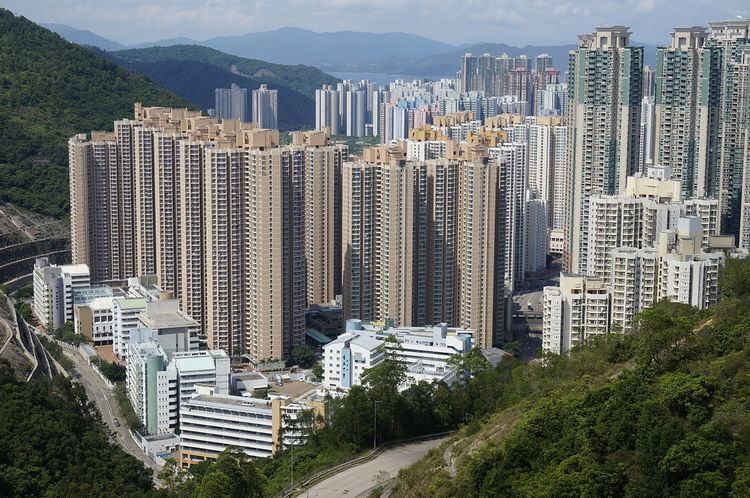Established 26 June 1950 | Address Tiu Keng Wan, Hong Kong | |
 | ||
hong kong hiking tiu keng leng
Tiu Keng Leng (also Rennie's Mill; Chinese: 調景嶺; Jyutping: tiu4 ging2 leng5; pinyin: Tiáojǐnglǐng) is an area of Hong Kong in the Sai Kung District adjacent to Tseung Kwan O (Junk Bay).
Contents
- hong kong hiking tiu keng leng
- Mtr c train a381 a382 tiu keng leng yau ma tei yau ma tei
- History
- Housing
- Transport
- Education
- References
The area used to be a refugee village housing former Kuomintang officials and followers who escaped to Hong Kong from Mainland China after the establishment of the People's Republic of China (PRC); however, the original Tiu Keng Leng village was cleared before Hong Kong's sovereignty transfer to the PRC in 1997, and nowadays Tiu Keng Leng is thoroughly redeveloped as part of the Tseung Kwan O New Town.
Mtr c train a381 a382 tiu keng leng yau ma tei yau ma tei
History
The earliest traceable name referring to the area nowadays known as Tiu Keng Leng was "Chiu Keng Leng" (照鏡嶺, lit. ridge of mirror reflection), being a reference to the clearness and calmness of the adjacent bay. The name was given by Tanka residents in the area.
Both the names "Tiu Keng Leng" and "Rennie's Mill" come from a 19th-century Canadian businessman named Alfred Herbert Rennie, who established the Hong Kong Milling Company at Junk Bay (his partners were Paul Chater and Hormusjee Naorojee Mody). The business failed, and Rennie drowned himself there in 1908, but was mistakenly reported that he hanged himself to death at that time. The incident gave the Chinese name for the site 吊頸嶺 (Tiu Keng Leng / Jyutping: diu3 geng2 leng5), meaning "Hanging (neck) Ridge", a pun on the name "Chiu Keng Leng" mentioned above. Because it was inauspicious, the name was later changed to similar-sounding 調景嶺 (Tiu King Leng / Jyutping: tiu4 ging2 leng5, which can be interpreted as "ridge of adjusting situation".)
On 26 June 1950 the Hong Kong Government's Social Welfare Office (the predecessor of the Social Welfare Department) settled a considerable number of refugees from China – former Nationalist soldiers and other Kuomintang supporters (according to official government account, there were 6,800 of them) – at Rennie's Mill, following the Chinese Civil War. The Hong Kong Government's original intention was to settle these refugees temporarily before they would be repatriated to Taiwan by the Kuomintang or to Mainland China by the Chinese Communists. But this day never came for the Kuomintang (under the auspices of a political-oriented charitable body named Free China Relief Association which became prominent after the government suspended food ration in 1953), the residents of the enclave became more supportive to the Kuomintang cause. Thus, by the late-1950s, in correlation with the Cold War context in Asia at the time, Rennie's Mill gradually became a "Bastion Against Communism", with the flag of the Republic of China flying (earning it the sobriquet "Little Taiwan"), its own school system and practically off-limits to the Royal Hong Kong Police Force until 1962 when the Hong Kong Government decided to turn it into a resettlement estate due to its apprehension of the growing Kuomintang presence in the enclave. It also had a significant missionary presence. Due to its pro-Kuomintang atmosphere, the 1967 Riots did not have an effect on Rennie's Mill.
In 1996 the Hong Kong government evicted the last of Rennie's Mill's original residents, ostensibly to make room for new town developments as part of the Tseung Kwan O New Town, but widely believed to be a move to please the Communist Chinese government before the transfer of the sovereignty of Hong Kong in 1997.
Housing
After the handover, the English name of the area was changed from "Rennie's Mill" to "Tiu Keng Leng", following the Cantonese name. Tiu Keng Leng became redeveloped as a modern high-rise residential district.
Metro Town is a private housing estate situated directly above the Tiu Keng Leng Station. With 9 towers built on top of a carpark/shopping mall podium, it is the tallest structure in the area.
To the south of Metro Town, by the seashore, also a private housing estate, is Ocean Shores. The site was previously used by Shiu Wing for its steelmill.
There are also 3 other public housing estates in the area, namely Kin Ming Estate, Choi Ming Court and Shin Ming Estate.
Transport
Before the redevelopment and reclamation in the surrounding area, Tiu Keng Leng could be reached by the winding, hilly and narrow Po Lam Road South, which ran past numerous busy quarries. At that time, Tiu Keng Leng's only means of public transport were the routes 90 and 290 of Kowloon Motor Bus, which were operated by minibuses, and by water transport.
After the redevelopment programme, Tiu Keng Leng is now served by the Tiu Keng Leng Station of the Tseung Kwan O Line and Kwun Tong Line of the MTR metro system.
Education
The Hong Kong Design Institute (HKDI) is well known for the shape of its building. Designed by French architects Coldefy & Associs, it resembles a piece of paper floating mid-air featuring a glazed box raised seven storeys above the ground on four lattice-steel towers that rest on a sloping, grass-covered podium. Total construction cost amounted to HK$1.2 billion, it was opened in November 2010.
The Hong Kong Institute of Vocational Education (IVE) – Lee Wai Lee campus is located next to HKDI. Also, the campus of Caritas Institute of Higher Education is located at Tiu Keng Leng. The institute has the aim of becoming the first Catholic University in Hong Kong.
